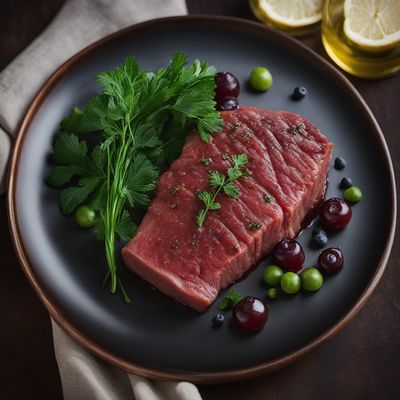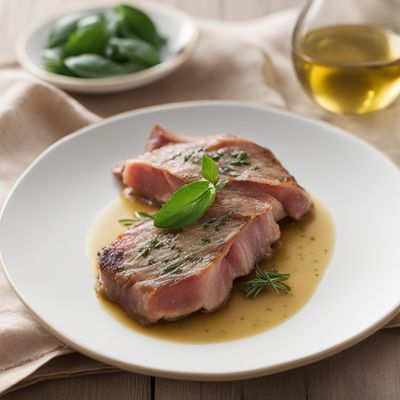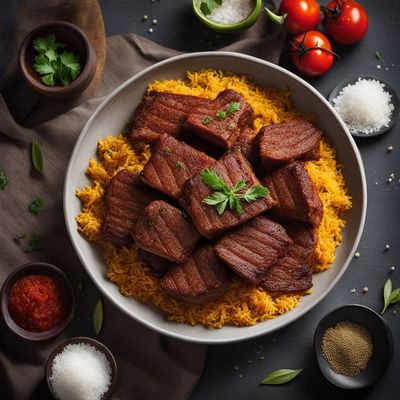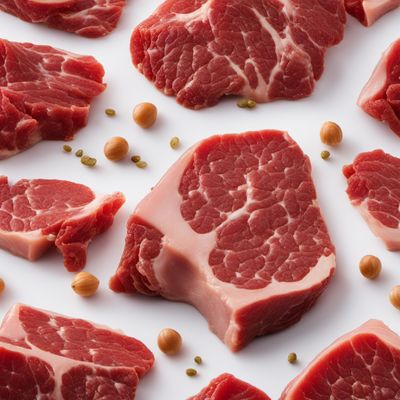
Ingredient
Veal liver
The Delicate Delight: Veal Liver
Veal liver is a pale pink to deep red organ meat that is known for its tender and delicate texture. It has a mild, slightly sweet flavor with a hint of earthiness. The liver is typically sliced and sautéed to perfection, resulting in a melt-in-your-mouth experience. It pairs well with onions, bacon, and tangy sauces, making it a versatile ingredient in various cuisines.
Origins and history
Veal liver has been enjoyed for centuries and holds a significant place in European cuisine. It has been a staple in traditional dishes like liver and onions, pâtés, and terrines. The liver is sourced from young calves, and its consumption dates back to ancient times, where it was considered a delicacy among the elite. Today, veal liver continues to be cherished for its unique flavor and culinary versatility.
Nutritional information
Veal liver is a nutrient-dense ingredient that is rich in protein, iron, vitamin A, and B vitamins. It is also a good source of copper and zinc. A 3-ounce serving of veal liver provides approximately 150 calories.
Allergens
Veal liver may cause allergic reactions in individuals with a known allergy to beef or other meats. It is important to exercise caution and consult a healthcare professional if you have any concerns or allergies.
How to select
When selecting veal liver, look for cuts that are firm and moist, with a vibrant pink or red color. Avoid liver that appears dry, discolored, or has a strong odor. Opt for organic or pasture-raised veal liver for the best quality and flavor.
Storage recommendations
To maintain the freshness and quality of veal liver, it should be stored in the refrigerator at a temperature below 40°F (4°C). It is best to wrap it tightly in plastic wrap or place it in an airtight container to prevent any odors from permeating. Use within 1-2 days of purchase for optimal taste and texture.
How to produce
Veal liver is typically produced by professional butchers or sourced from specialty farms. It requires specific knowledge and expertise to ensure proper handling and preparation. It is not recommended for amateur production due to the complexity involved.
Preparation tips
Veal liver can be prepared in various ways, including sautéing, pan-frying, or grilling. It is important not to overcook the liver to maintain its tenderness. Pair it with caramelized onions, crispy bacon, or a tangy sauce to enhance its flavor. Soaking the liver in milk before cooking can help reduce any potential bitterness. Additionally, slicing the liver thinly and marinating it in herbs and spices can add depth to the dish.
Substitutions
Chicken liver can be used as a substitute for veal liver, although it has a slightly stronger flavor. If you prefer a milder taste, beef liver can also be used as a substitute. However, keep in mind that the flavor and texture may differ slightly from veal liver.
Culinary uses
Veal liver is commonly used in dishes such as liver and onions, pâtés, terrines, and liver mousse. It can also be incorporated into pasta sauces, stir-fries, and salads. Its versatility allows it to shine in both traditional and modern culinary creations.
Availability
Veal liver is commonly available in Europe, particularly in countries like France, Italy, and Germany. It can also be found in specialty butcher shops or gourmet markets in other regions.
More ingredients from this category
Recipes using Veal liver » Browse all

Danish-inspired Wakame Noodle Salad
Nordic Seaweed Delight: Danish-inspired Wakame Noodle Salad

Crispy Fried Fish with Beijing Flavors
Beijing-style Crispy Fish: A Fusion of Flavors

Estonian-style Veal Liver
Sautéed Veal Liver with Estonian Flavors

Saltimbocca alla Romana
Savory Veal Medallions with Prosciutto and Sage

Yemeni-inspired Spiced Nigiri Sushi
Zesty Spice Fusion: Yemeni-inspired Nigiri Sushi

Ossobuco alla Milanese
Saffron-infused Braised Veal Shanks with Gremolata

Bavarian Cordon Bleu
Bavarian Delight: Crispy Cordon Bleu with a Bavarian Twist

Tagliatelle al ragù alla Bolognese
Elevated Tagliatelle with Haute Cuisine Bolognese Ragù

Fuži with White Istarski Truffle
Truffle-infused Noodle Delight: A Chinese Buddhist Twist on Croatian Cuisine

Grilled Pork Satay with Peanut Sauce
Indonesian Delight: Grilled Pork Satay with Irresistible Peanut Sauce

Croatian-style Lasagne
Layers of Croatian Delight: Traditional Croatian Lasagne

Anglo-Indian Spiced Beef Steak
Sizzling Spices: Anglo-Indian Twist on Beef Steak
